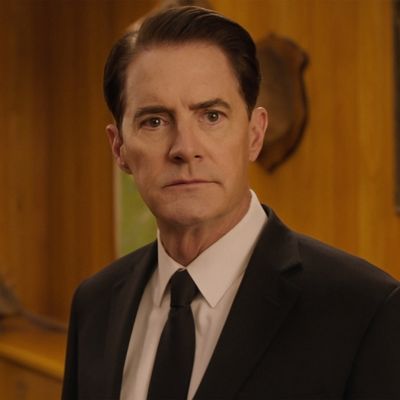
Well, what did you expect from David Lynch? A happy ending?
Twin Peaks: The Return ended, if ended is the right word, with back-to-back episodes. The first offered a series of supernatural eruptions followed by hints of traditional closure and satisfaction, to the extent that series creators Lynch and Mark Frost were able to provide such things — but from the 30-minute mark onward there were signs that, beneath the veneer of order-from-disorder, something else was afoot. The final episode seemed to flip everything upside-down, turn it inside-out, then pull it through an electrical socket and cast it out upon the Purple Sea.
The more I think about it, the more convinced I am that — like the last scene of David Chase’s Peaks-influenced The Sopranos — this was the perfect ending/non-ending to everything that had come before. It was in character with Twin Peaks: The Return as well as with the second half of Lynch’s career as a filmmaker, shamanistic shit-stirrer, superstar anti-celebrity, and American pop culture’s answer to Werner Herzog. Every frame of this thing has been the scripted-TV equivalent of what clichéd tech industry executives call “a disruption” — a rock hurled through prestige TV’s stained-glass window.
At the start of “Part 17,” Special Agent Gordon Cole (David Lynch) tells his colleagues that one of the founders of the Blue Rose unit of the FBI, which was created to deal with supernatural or uncanny cases, “doesn’t even exist anymore, at least not in a normal sense.” The same is true of Twin Peaks, Lynch and Mark Frost’s original series. No matter how badly we might have wished for The Return to satisfy and frustrate in more or less the same manner as the original Peaks, it was never going to happen, because over the past quarter-century, Lynch has become even more of a free-associative, nonlinear, non-rational filmmaker than he was back in the ’80s and early ’90s, when The Elephant Man, Blue Velvet, the original Peaks, and Wild at Heart briefly made him a mainstream darling. (One could also argue, as I did here, that we collectively have a false memory of Peaks, a show that became more scattered, baffling, and gleefully indulgent as it went along.)
Every episode of The Return reminded us — at times seemed to caution us — that the old Twin Peaks does not exist anymore, at least in a normal sense. Sure enough, The Return ended up bearing as much relation to its predecessor as FBI Agent Phillip Jeffries, played in Twin Peaks: Fire Walk With Me by David Bowie, does to the enormous talking teakettle that now bears his name. What we’re left with is a piercing series of reminders that you can’t go home again, that what was done can’t be undone or redone, that any attempt to reduce experience to a series of definitive factual proclamations is sure to end in frustration. Laura Palmer is still dead. The woman that Cooper meets in the final episode has a different name, and when he takes her to her mother’s house, they find a new woman who never heard of Laura or Sarah Palmer. (The woman’s name is Alice Tremond, and she says she bought the house from a Mrs. Chalfont — two names associated with a Lodge spirit in Twin Peaks: Fire Walk With Me). Any attempt to reincarnate the dead or missing in The Return, whether through resurrection or the creation of doppelgängers, results in a ghoul, a mannequin, or some other disquieting imposter. And yet the act of considering various, often foolhardy or sinister forms of reincarnation has resulted in the most original and disturbing show to hit TV drama since The Sopranos, maybe even since the first Peaks itself.
I named The Return the year’s best show less than halfway through its run, writing, “We don’t so much watch Twin Peaks: The Return as give ourselves over to the look and sound of it, as we might give ourselves over to a painting, a sculpture, or a piece of music.” Not only do I stand by that assessment, I’m doubling down on it. While I’m intrigued by the granular cosmology of Lynch and Frost’s universe, it is not the aspect of the series that interests me most. Nor do I think that drawing connective lines between one scene and another will get us any closer to “getting” the show on the level of traditional narrative. The overwhelming, inscrutable totality of this thing defeats attempts to tame it by decoding it. Lynch and Frost have gone beyond the basic dichotomies of satisfying/not satisfying, happy/sad, and comprehensible/mystifying, creating a work so original and confounding that it might have been transmitted from the Black Lodge, its backwards-talk presented without subtitles.
I also stand by another early take on the series, which suggested that Lynch started out as a painter and in some ways has remained a painter at heart, creating work that’s alternately surreal, expressionistic, and abstract, but always more concerned with the emotional and intellectual effects of light, darkness, composition, and tone (and such cinematic values as sound design, editing patterns, and the interplay of music and acting) than with telling an A-to-Z story that explains what everything meant. “Imagine the totality of Twin Peaks: The Return as an enormous mosaic painting consisting of 18 individual panels,” I wrote. “Each panel is hidden by a strip of black construction paper, and the artist removes them one at a time, giving you ten minutes to study one panel before revealing the next. That sounds like an infuriating way to look at a painting. But if somebody showed you a painting that way, and you committed to their way of showing it to you, the result would be an experience you would never forget. You might get confused, bored, or angry sometimes, or wonder if the exercise was unnecessarily silly or pretentious. You might even come away thinking the experience was not worth the time you invested. But for the rest of your life, there would be moments when you’d flash back to the time that that painter invited you into the studio and unveiled a work one square at a time, then stood back while you looked at it.”
On that note, let’s look at the last two panels of this painting and consider them in relation to the other 16.
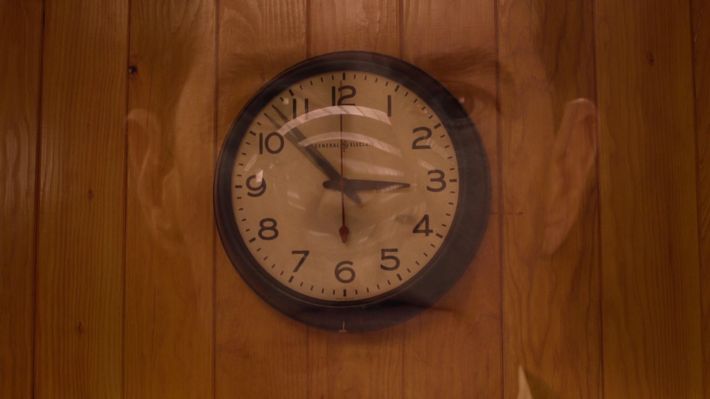
In the Twin Peaks Sheriff’s Department, Freddie Sykes (Jake Wardle), the security guard with the pile-driving, green-gloved fist, embraces his destiny and defeats the demon BOB, represented by the late actor Frank Silva’s face superimposed on a fiendish orb. Then we see a succession of curious moments, including Agent Cooper (Kyle MacLachlan) placing a green ring on the finger of a slain Evil Cooper. (As explained here, the ring is part of Twin Peaks lore, either protecting its wearer from harm or certifying their death.) Then the eyeless Naido (Nae Yuuki) approaches Cooper, places her hands against his, and becomes Cooper’s beloved Diane (Laura Dern), whose doppelgänger was dispatched by gunshot in Cole’s office at the end of the previous episode.
Then there’s a shot of a clock on the wall: The time is almost 2:53 p.m., the digits of which add up to ten, a number that Cooper described in his message to Cole as “the number of completion.” The clock keeps straining towards 2:53 but always clicks back to 2:52. The stutter-step motion of the clock’s second hand evokes the strobelike, backward-forward motion of bodies trying to move or speak within the Black Lodge. Completion denied. (In episode three, the Evolution of Arm also told Cooper that 2:53 was the time when he could enter or leave the Black Lodge. For more about this numerology, see here.)
Superimposed over the shot of the clock, and remaining onscreen continuously throughout much of this scene in Truman’s office, is a tight close-up of Cooper’s face, implying that what we are seeing here — and perhaps afterward, and maybe before that, too — is happening in Cooper’s imagination. Is he also still imprisoned in another dimension? Did either good or bad Cooper ever truly leave their “home” on the other side? “We live inside a dream,” says the voice of Bad Coop. The voice’s syrupy bass tone is reminiscent of the scene in episode four where the hero’s doppelgänger, imprisoned by the FBI and drained of the negative energy that made him able to pass as human, is at his most zombielike, a black-eyed automaton radiating icy menace.
Then the room darkens, a Lynchian air whoosh fills the soundtrack, and we get an uninterrupted closeup of Cooper’s face with nothing superimposed over it. (We’ll get this again periodically throughout the next sequence.) Cooper, Cole, and Diane walk through a space so dark that I won’t even try to assert where, exactly, they are — not Cooper’s old hotel room at the Great Northern, though he opens a door with the key Dougie’s mistress mailed to the FBI earlier in the season.
Cooper and Mike walk a lonely road at night, then enter the grounds of the motel seen in “Part 15” when Bad Cooper talked to Teakettle Jeffries about Jowday, a.k.a. Judy — an extradimensional later described by Cole as “an extreme negative force,” and presumably a greater threat to good than anything we’ve seen previously. (When Bad Cooper asked Teakettle Jeffries what Judy wanted from him, he was told, “You’ve already met Judy.”) Is Judy the faceless white demon creature that mauled that couple in the New York lab in episode two, and that was briefly glimpsed in episode eight extruding an ectoplasmic trail that contained the BOB orb, which itself would emerge from Bad Coop’s corpse in the sheriff’s office?
As Cooper talks to Teakettle Jeffries, a puff of steam emanating from the teakettle’s spout takes the shape of the Owl Cave rune, another part of Peaks lore discussed here. Its wings break off and float over the rune’s body, forming a figure eight, the same number glimpsed on the door of that very motel room, and it becomes an infinity symbol when turned on its side. It’s worth noting that “Part Eight” of The Return happens to be the episode that links the first use of the atom bomb with the creation of BOB and Laura and the first terrestrial visitation of the skull-crushing Woodsmen.
This is all mere prelude to the shattering climax of episode 17, which finds Cooper materializing in Twin Peaks on February 23, 1989, the date when Laura Palmer (Sheryl Lee) disappeared. Presented in black-and-white — like all flashbacks on The Return, including the Woodsmen sequence in episode eight as well as flashbacks to the original series and Fire Walk With Me — this is one of the most aggressively meta moments in any incarnation of the show, which is saying a lot. In a sequence reminiscent of the end of — of all things! — Back to the Future Part II, Cooper witnesses Laura’s last night from afar, intervenes to prevent her death, then loses her again as the sequence acquires a hint of color in its final moments. We get a devastating point-of-view shot of Cooper anxiously scanning a dim forest for Laura, her screams drowning out the roar of wind through the trees. It’s the sound of a spirit sloughing off its mortal coil, also heard in various Red Room moments where Laura whispers a secret to Cooper only to be whisked away.
This disquieting closing image gives way to original Twin Peaks chanteuse Julee Cruise performing in the Roadhouse, which over the course of 17 episodes has started to feel like as much of an ethereal in-between space as the Red Room. Cruise sings a song titled “The World Spins,” written by Lynch himself:
Love, don’t go away,
Come back this way,
Come back and stay forever,
And ever.
Sandwiched between the scenes of Laura and Cooper in the woods are flashbacks to original series characters Josie Packard (Joan Chen) and Pete Martell (Jack Nance, star of Lynch’s debut feature Eraserhead, who died in 1996, and to whom this episode is dedicated); and a scene of a distraught Sarah Palmer (Grace Zabriskie) pulverizing the iconic homecoming photo of her murdered daughter. The latter is an act that expresses the rage of survivors unable to undo, or even fully accept, the sudden loss of a loved one, but perhaps also Lynch and Frost’s mixed emotions at being so strongly identified with one work.
“Part 18” starts with Bad Coop in the Red Room, roasting in a chair. He’s replaced by one of those little gold nuggets, which transforms into a replacement Dougie Jones, who rejoins Janey-E (Naomi Watts) and Sonny Jim (Pierce Gagnon) in Las Vegas. (“Electricity,” says the disembodied voice of Mike, the last explicit reference to an elemental force that is seen and heard throughout the show.) We get a replay of Laura whispering in Cooper’s ear, then being violently whisked away from him, an image repeated throughout various incarnation of Peaks, and which echoes Cooper losing Laura in the forest. Leland Palmer (Ray Wise), who murdered Laura while under the control of BOB, reappears here, seemingly on the edge of tears, and entreats Cooper to “Find Laura.” Intriguingly, Cooper then enters another “forest” of sorts, comprised of spindly, leafless trees akin to the Evolution of the Arm, and it’s here that he reencounters Diane, who over the course of this episode will begin to feel like a stand-in for Laura (or perhaps the memory, or the idea, of Laura).
Cooper will eventually lose Diane as well, following a tryst in a motel room scored with the Platters’ “My Prayer.” This song was last heard in episode eight, where it accompanied scenes of a Woodsman crushing the skulls of radio-station employees before taking over the microphone and broadcasting a poem that made inhabitants of the town fall into a deep sleep:
This is the water,
and this is the well.
Drink full, and descend.
The horse is the white of the eyes,
and dark within.
Like everything else in this episode and the prior one, there are many touches in this sex scene that seem deliberately “off” and disquieting, starting with the lighting of the motel at night, which conjures memories of other nightmarish Twin Peaks spaces, including the spaces where Good Coop and Bad Coop interacted with Teakettle Jeffries, and the convenience store frequented by the Woodsmen (who were first glimpsed in a different incarnation in Twin Peaks: Fire Walk With Me).
Beyond that, a couple of fascinating things happen in this sex scene. One is that it seems to be a light mirror of the darkest moment in Diane’s life: her rape years earlier by Bad Cooper. The scene feels like a repudiation-by-reenactment of that horrific assault, this time with the consent of Diane, who gives herself to a man with whom she’s always had a powerful mutual attraction. (“We’re finally going to do this,” she says on the drive to the motel.) But Cooper’s reaction messes with this reading. Diane’s expressions and movements initially suggest ecstasy and liberation, but he scrutinizes her face and body coldly, in more of a Bad Coop than Good Coop way, and she keeps covering up his face with her hands (which raises the possibility that we’re actually seeing a version of the Bad Coop rape itself, previously only described in Diane’s monologue to the FBI agents). Diane sneaks away the next morning, leaving a note that addresses him as “Richard.” “Please don’t try to find me,” it says. “I don’t recognize you anymore. Whatever we had together is over.” Inexplicably, the note is signed “Linda.” (Or maybe not inexplicably: In the first scene of the first episode, the Fireman warned Cooper, “Remember Richard and Linda.”)
This episode has a lot, and I mean a lot, of longueurs, in particular shots of Cooper driving with Diane or Cooper driving with Laura — who, upon being reencountered in Odessa, Texas, insists that she’s named Carrie Page — as well as unexplained moments of horror, most of which are presented in an emotionally neutral way. After he tracks Carrie down in Odessa, Texas, she leads Cooper into her house to the buzzing of flies, whereupon he spies the corpse of a man who’s been shot through the forehead — the last of many brain-obliterating assaults inflicted on people in this show. The killing is never mentioned again.
The very last scene of Twin Peaks: The Return does feel shockingly definite, though in a way that can’t be explained as such via charts, lists, numerical analyses, or any other left-brained organizational technique. After Laura/Carrie is rejected at the door of the old Palmer home, Cooper asks, “What year is it?” then we hear a variant of that now-familiar and still-chilling wind through the trees, and Laura screams again as the house’s lights short out. Cut to black, roll credits over a very subtle superimposition of Laura whispering into Cooper’s ear.
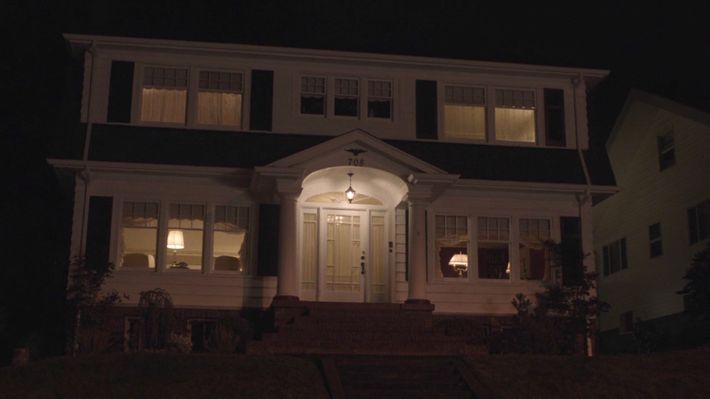
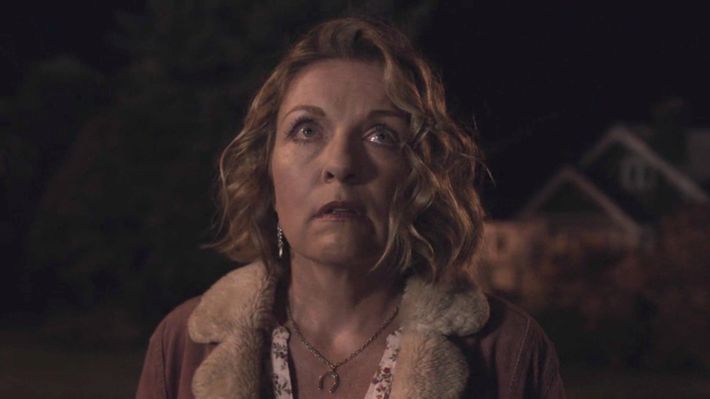
My first thought after this closing image was, “Laura is gone and she’s never coming back,” followed by, “Neither is Cooper,” and then finally, “What nerve of Lynch and Frost to make an 18-episode continuation of Twin Peaks that seems to be predicated on the idea that what’s done can never be undone or redone, so we might as well all give up on the idea.”
This is, of course, a drastic oversimplification of the show and its message, if indeed it can be said to have a message. It’s more accurate to say that Twin Peaks: The Return is a playful, painful, frustrating, horrifying, occasionally sublime working-through of this idea and many more. Directly related to this notion of refusing to let go is Lynch and Frost’s ongoing, pointed meditation on age and mortality. (“Frequently, Twin Peaks: The Return seemed to commune with the dead and resurrect the souls of those who seemed lost,” my colleague Jen Chaney wrote, talking about what the show meant to her and her mother.) This idea is expressed in all sorts of ways, some incidental, others deliberate and touching. The roll call of posthumously appearing cast members includes Catherine Coulson as Margaret Lanterman (a.k.a. the Log Lady) and Miguel Ferrer as Albert Rosenfield, as well as Peaks alumni David Bowie, Frank Silva, Don S. Davis, and Jack Nance (appearing via flashback or CGI compositing).
Earlier in the season, Deputy Chief Hawk (Michael Horse) gets to say an incremental good-bye to his old friend Margaret in a moving series of phone conversations. In the final one, Margaret tells Hawk, “You know about death — that it’s just a change, not an end,” which would sound more reassuring on a series where people didn’t get trapped in extradimensional space or transformed into talking teakettles. Then, over the sound of wind moaning, she adds, “It’s time. There’s some fear in letting go.” She concluded, “My log is turning gold. The wind is moaning. I’m dying. Good night, Hawk.”
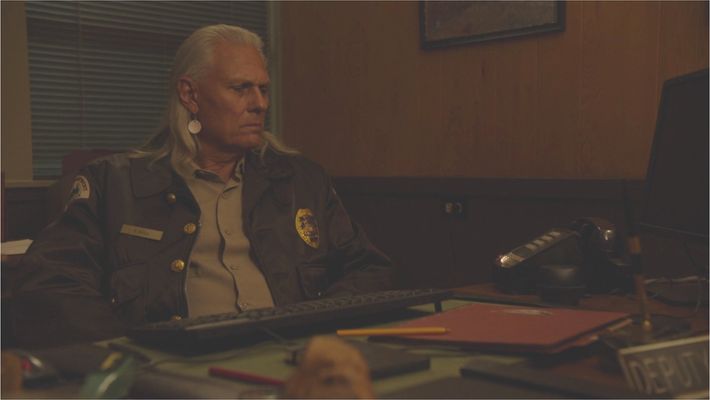
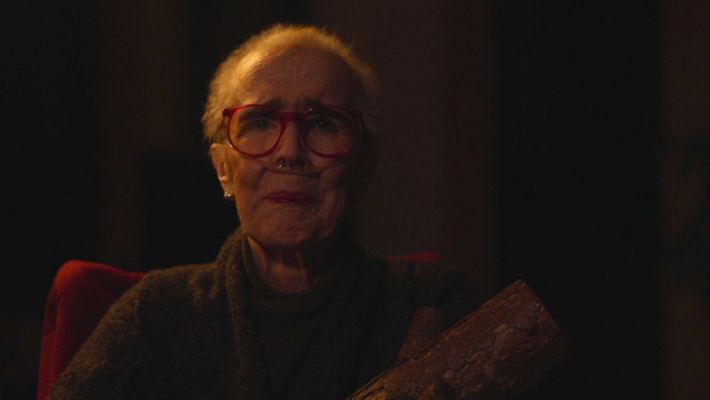
Ferrer’s scenes opposite Lynch are likewise charged with extra-dramatic awareness of illness and death — not all of it imported by viewers who know that Ferrer died in January. The eeriest occurs near the end of episode four, right after Albert admits to Cole that he told Philip Jeffries the identity of an FBI agent in Colombia, who was subsequently murdered. Cole then repeats his colleague’s name three times during the course of an exchange of close-up that lasts almost 30 seconds — an eternity even by the standards of Lynch, the king of the elongated pause.
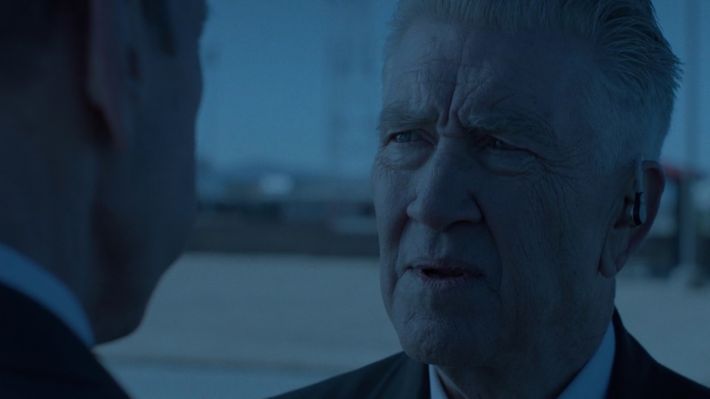
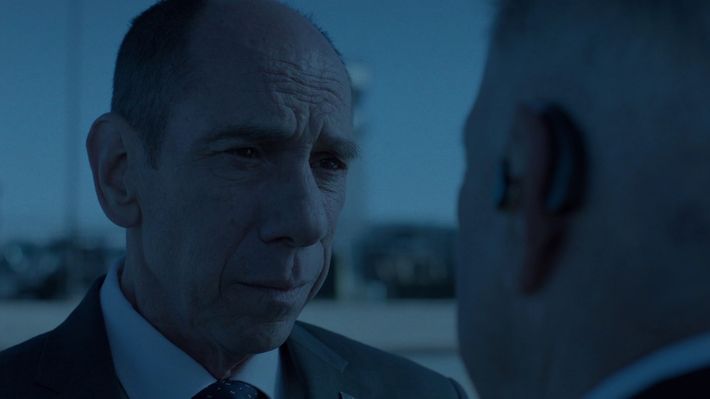
The framing on both men is tight enough to compel close examination of the wrinkles and folds in their skin, and something about the entire construction of this moment — the blue-and-white color scheme, redolent of morgues or the interiors of meat lockers; the low whistling on the soundtrack, suggesting either distant wind or an insect swarm — turns it into something more than an admission of past professional indiscretion. “Albert,” Lynch says three times, to an actor and friend who was dying of terminal cancer. (According to the New York Times, Lynch “almost always” called him Albert instead of Miguel.) The moment is shattered by Albert grinding his heel on the pavement and setting off feedback in Cole’s hearing aid, which has been “turned up to the max.”
Lynch is no spring chicken, of course. He turned 71 this year, and for all the regrettable, dirty-old-man-isms that found their way into his scenes — including a butt shot of Chrysta Bell’s agent Tammy Preston, and Cole insisting to Albert that he still has lead in his pencil — there’s a pervasive awareness of Lynch here as an old man eager to acknowledge his age within the context of The Return. He does so through filmmaking choices (in particular the unforgiving lighting on his face), through his script with Frost (which goes out of its way to remind us of how long Cole has been with the FBI, and which presents a hotel-room visit by a much younger woman as being mainly about companionship), and most of all through the non-Cole scenes that consider the inescapable wear and tear of the years, the ruptures and changes in relationships (through death, divorce, remarriage, and relocation), and the inevitable displacement of one generation by the next. (The show’s younger cast is thick with next-gen Peaks characters, many of whom are struggling with addiction, rage issues, depression, or all three.) The passage of time dims the sting of loss, but never entirely subsumes it. The clearest illustration of this is the moment when Bobby, now 25 years older and a respected, well-adjusted cop, spots Laura’s prom photo on a table full of evidence and bursts into tears. Sarah is still shattered by Laura’s death, chain-smoking and drinking her way through the days, fixating on footage of lionesses killing a water buffalo. (The destruction of the buffalo’s face echoes the white demon’s mutilation of the couple in the New York lab. Could Judy, the most powerful monster in the Lynch-Frost universe, be the Grim Reaper with a different name and a fresh backstory?)
Even the Dougie Jones scenes have a touch of screwball Lynchian death-meditation about them. As my friend Jesse Clark Tucker pointed out on Facebook yesterday, “It’s the common interpretational consensus that Eraserhead is ‘about’ Lynch’s rough time in Philadelphia as a struggling new husband and father, even though he’s never confirmed this. Springing off that I’ve been reading the Dougie Jones sections of Twin Peaks as perhaps Lynch’s commentary on aging. You wake up one day, completely disoriented, surrounded by people you don’t really know, walking around the locations of your life in a sustained daze, moved by objects from your past you only half remember, indefinable tokens blazing through the ominous quotidian.” The scenes of Janey-E helping her husband struggle with ordinary tasks like eating, dressing, and going to the bathroom are less reminiscent of Being There or Forrest Gump than scenes playing out all over the world right now between elderly people and their younger loved ones or caretakers. In the only scene of Beverly Paige (Ashley Judd) at home, we meet her husband Tom (Hugh Dillon), who appears to be dying of a terminal illness. He accuses her of infidelity and she’s guilty, but it’s also clear that he’s so far gone physically that he can no longer satisfy her. So many characters on this show are living in emotional wreckage of one kind or another, and the key to their happiness lies in managing it rather than denying its existence.
Meanwhile, “Part Eight” can be read as one of the most overtly political-historical works of Lynch’s career — the atom bomb, a manmade device of Old Testament force, marking the point where the human capacity for evil overshadowed its potential for goodness — but it also works as a metaphor for the awesome transformative impact of Laura’s death on the lives of everyone who knew her or worked on her case. When Bad Coop is resurrected by the Woodsmen, the episode cuts to Nine Inch Nails singing, “She’s gone/She’s gone/She’s gone away.” After that, we flash back to the detonation of the first A-bomb on July 16, 1945, in New Mexico.
Other mortality-haunted elements in The Return include a child’s bloody death in a hit-and-run accident, and the revelation that when Doris Truman (Candy Clark), wife of Sheriff Frank Truman (Robert Forster), berates him, she’s projecting her anger over the suicide of their only son, a combat veteran. The latter revelation adds a layer of melancholy depth to one of the weirdest and most delightful monologues in the show, by Wally Brando (Michael Cera), who returns home after many years of following the trail of “Lewis and his friend Clark” to tell his parents Lucy (Kimmy Robertson) and Andy (Harry Goaz) that it’s okay to change his old room into a study. The final shot in the scene tracks forward in front of Sheriff Truman as he leaves Wally, Andy, and Lucy in the parking lot; he exits the frame, leaving us with a shot of the intact nuclear family that he and his wife will never have.
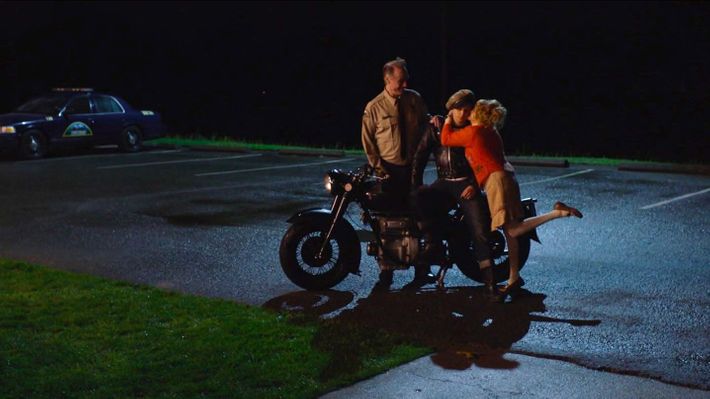
This is just one way of looking at the remarkable creation that is Twin Peaks: The Return. I’ve touched on others here and elsewhere on the site. My colleagues at Vulture and elsewhere have considered many more. As was the case 25-plus years ago, some of the most original writing on the show has been done by fans, notably at Welcome to Twin Peaks and by @fatecolossal, definitely the viewer to beat when it comes to exhaustive analysis of numerical and visual patterns. (Check out “The Dream of Time and Space.”) I look forward to the articles and books that will surely be written about the Peaks universe now that there’s 18 more hours of it. Because it’s all so singular, so deliberately constructed to provoke subjective, personal responses, I’m sure that we’ll see little overlap from one take to the next.
I’ll leave the last word on this mosaic television painting-in-motion to the work of a poet, John Ashbery, who died over the weekend and who was reportedly a big fan of David Lynch, and of Inland Empire in particular. (In the ’70s, Ashbery was also the art critic for New York Magazine.) Summing up Ashbery’s poetry in The New Yorker, Paul Muldoon wrote, “A world that is complex requires a poetry that is complex; a world that is somewhat incoherent may actually demand a poetry that is itself incoherent; a world in which no conclusions apply may even revel in its inconclusiveness. To read a John Ashbery poem is to be scrutinized by it. It is less a recording than a recording device, a CCTV screen taking us in.”


